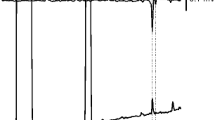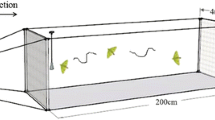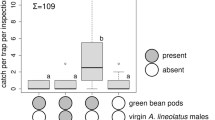Abstract
The sex pheromone of the hibiscus flower borer Rehimena surusalis (Walker) (Lepidoptera: Crambidae) was analyzed by gas chromatography with electroantennographic detection (GC-EAD) and GC-mass spectrometry (GC/MS). Three EAD-active components were found in crude pheromone gland extracts of calling females. GC/MS and GC analyses using synthetic chemicals and derivatization of the extracts identified three components as (10E,12Z)-hexadeca-10,12-dienal (E10,Z12-16:Ald,), (10E,12E)-hexadeca-10,12-dienyl acetate (E10,Z12-16:OAc), and (3Z,6Z,9Z)-tricosa-3,6,9-triene (Z3,Z6,Z9-23:HC). In field tests, male moths were strongly attracted to a ternary blend of E10,Z12-16:Ald, E10,Z12-16:OAc, and Z3,Z6,Z9-23:HC at a ratio of 1:5:14, but single and binary blends showed only weak or no attraction.




Similar content being viewed by others
References
Ades GWJ, Kendrick RC (Eds) (2004) Hong Kong fauna- a checklist of selected taxa, fauna conservation, Department Kadoorie Farm & Botanic Garden Corporation, 87 pp
Ando T (2014) Internet database: http://www.tuat.ac.jp/~antetsu/LepiPheroList.htm
Ando T, Ogura Y, Uchiyama M (1988) Mass spectra of lepidopterous sex pheromones with a conjugated diene system. Agric Biol Chem 52:1415–1423
Ando T, Inomata S, Yamamoto M (2004) Lepidopteran sex pheromone. Top Curr Chem 239: 51–96
Ando T, Kawai T, Matsuoka K (2008) Epoxyalkenyl sex pheromones produced by female moths in highly evolved groups: biosynthesis and its endocrine regulation. J Pestic Sci 33: 17–20
Anonymous (1994) Check list of insects from Korea. Kon-kuk University Press, Seoul, 744 pp
Anonymous (2006) Major insect and other pests of economic plants in Japan, revised edn. The Japanese Society of Applied Entomology and Zoology, Tokyo, 381 pp
Bea Y. (2012) The final report of researches for publication of Korean Red List: Insects. Nat. Inst. Biol. Res, Biol. Res. Co. Div. 164pp. (in Korean)
Cabrera A, Eiras AE, Gries G, Gries R, Urdaneta N, Mirás B, Badji C, Jaffe K (2001) Sex pheromone of tomato fruit borer, Neoleucinodes elegantalis. J Chem Ecol 27: 2097–2107
Cork A, Chamberlain DJ, Beevor PS, Hall DR, Nesbitt BF, Campion DG, Attique MR (1988) Components of female sex pheromone of spotted bollworm, Earias vittella F. (Lepidoptera: noctuidae): identification and field evaluation in Pakistan. J Chem Ecol 14: 929–945
Dai XJ, Xu SF, Wang MZ, Zhu YX, Tang XH, Zhu JW, Du JW, Dong TX, Du MZ (1988) 10E,12Z-hexadecedienyl acetate - sex pheromone of the mulberry white caterpillar Rondotia menciana Moore (Lepidoptera: bombycidae). Kexue Tongbao 33: 1575–1576
Daimon T. Fujii T, Yago M, Hsu YF, Nakajima Y, Fujii T, Katsuma S, Ishikawa Y, Shimada T (2012) Female sex pheromone and male behavioral responses of the bombycid moth Trilocha varians: comparison with those of the domesticated silkmoth Bombyx mori. Naturwissenshaften 99: 201–215.
Dool HD, Kratz PD (1963) A generalization of the retention index system including linear temperature programmed gas—liquid partition chromatography. J Chromatogr 11: 463–471
El-Sayed AM, Gibb AR, Mitchell VJ, Manning L-AM, Revell J, Thistleton B (2013) Identification of the sex pheromone of Conogethes pluto: a pest of alpinia. Chemoecology 23:93–101
Gibb AR, Pinese B, Tenakanai D, Kawi AP, Bunn B, Ramankutty P, Suckling DM (2007) (Z)-11-hexadecenal and (3Z,6Z,9Z)-tricosatriene: sex pheromone components of the red banded mango caterpillar Deanolis sublimbalis. J Chem Ecol 33: 579–589
Grant GG, Frech D, MacDonald L, Slessor KN, King GGS (1987) Copulation releaser pheromone in body scales of female whitemarked tussock moth, Orgyia leucostigma (Lepidoptera: lymantriidae): identification and behavioral role. J Chem Ecol 13: 345–356
Herbison-Evans D, Crossley SA (2013) Australian spilomelinae - Lepidoptera larvae of Australia, http://lepidoptera.butterflyhouse.com.au/spil/spilomelinae.html
Honda H, Himeno K, Yoshiyasu Y (1994) Chemotaxonomy of the cotton leaf-roller (Lepidoptera: pyralidae) in Japan with special reference to differences in sex pheromones. Appl Entomol Zool 29: 323–330
Inoue H, Sugie S, Kuroko H, Moriuti S, Kawabe A (1982) Moths of Japan I. Kodansha, Tokyp, Japan
Kim Y, Cho Y, Kang Y-K, Choi M, Nam S-H (2013) A study of the major insect pest communities associated with Hibiscus syriacus (columniferae, malvaceae). J Ecol Environ 36: 125–129
Kováts E (1958) Gas-chromatographische charakterisierung organischer verbindungen. Teil 1: retentionsindices aliphatischer halogenide, alkohole, aldehyde und ketone. Helv Chim Acta 41:1915–1932
Leal WS, Parra-Pedrazzoli AL, Kaissling KE, Morgan TI, Zalom FG, Pesak DJ, Dundulis EA, Burks CS, Higbee BS (2005) Unusual pheromone chemistry in the navel orangeworm: novel sex attractants and a behavioral antagonist. Naturwissenschaften 92: 139–146
Lee, SY, Nam SH and Seok O (2005) Insect community complex of Hibiscus syriacus. 2005 ESA Annual meeting, http://abstracts.co.allenpress.com/pweb/esa2005/document/49852
Löfstedt C, Svensson GP, Jirle EV, Rosenberg O, Roques A, Millar JG (2012) 3Z,6Z,9Z,12Z,15Z)-pentacosapentaene and (9Z,11E)-tetradecadienyl acetate: sex pheromone of the spruce coneworm Dioryctria abietella (Lepidoptera: pyralidae). J Appl Entomol 136: 70–78
McElfresh JS, Millar JG (1999a) Sex pheromone of the common sheep moth, Hemileuca elganterina, from the San Gabriel mountains of California. J Chem Ecol 25: 687–709
McElfresh JS, Millar JG (1999b) Sex attractant pheromone saturniida moth, Coloradia velda. J Chem Ecol 25: 1067–1078
McElfresh JS, Millar JG (1999c) Geographic variation in sex pheromone blend of Hemileuca electra from southern California. J Chem Ecol 27: 1409–1422
McElfresh JS, Hammond AM, Millar JG (2001) Sex pheromone components of the buck moth Hemileuca maja. J Chem Ecol 25: 2505–2525
Millar JG, Grant GG, McElfresh JS, Strong W, Rudolph C, Stein JD, Moreira JA (2005) Pheromone component of the fir coneworm moth, Dioryctria abietivorella. J Chem Ecol 31: 1229–1234
Miller JS (1991) Cladistics and classification of the notodontidae (Lepidoptera, noctuoidea) based on larval and adult morphology. Bull Am Mus Nat Hist 204:1–230
Regier JC, Zwick A, Cummings MP, Kawahara AY, Cho S, Weller S, Roe A, Baixeras J, Brown JW, Parr C, Davis DR, Epstein M, Hallwachs W, Hausmann A, Janzen DH, Kitching IJ, Solis MA, Yen SH, Bazinet AL, Mitter C (2009) Toward reconstructing the evolution of advanced moths and butterflies (Lepidoptera: Ditrysia): an initial molecular study. BMC Evol Biol 9: 280
Schlamp KK, Gries R, Khaskin G, Brown K, Khaskin E, Judd GTR, Gries G (2005) Pheromone components from body scales of female Anarsia lineatella induce contacts by conspecific males. J Chem Ecol 31:2897–2911
Shibuya J (1929) On the known and unrecorded species of the Japanese pyraustinae (lepid.). J Fac Agric Hokkaido Imp Univ 25:151–242
Shin YH (2001) Coloured Illustrations The moths of Korea. Academy Book Publishing Co., Seoul. (In Korean.)
Uehara T, Naka H, Matsuyama S, Ando T, Honda H (2012) Identification and field evaluation of sex pheromones in two hawk moths Deilephila elpenor lewisii and Theretra oldenlandiae oldenlandiae (Lepidoptera: sphingidae). Appl Entomol Zool 47: 227–232
Uehara T, Naka H, Matsuyama S, Ando T, Honda H (2015) Sex pheromone of the diurnal hawk moth, Hemaris affinis. J Chem Ecol 41: 9–14
Witzgall P, Kirsch P, Cork A (2010) Sex pheromones and their impact on pest management. J Chem Ecol 36: 80–100
R core team (2013) R: A language and environment for statistical com- puting. R Foundation for Statistical Computing, Vienna, URL http://www.R-project.org/
Xiao W (2011) Identification and function of body wax hydrocarbons as a sex pheromone of the yellow peach moth. PhD dissertation of the University of Tsukuba, 97 pp
Xiao W, Honda H (2010) Non-polar body waxes enhance sex pheromone activity in the yellow peach moth, Conogethes punctiferalis (guene’e) (Lepidoptera: crambidae). Appl Entomol Zool 45: 449–456
Xiao W, Honda H, Matsuyama S (2011) Monoenyl hydrocarbons in female body wax of the yellow peach moth as synergists of aldehyde pheromone components. J Chem Ecol 46: 239–246
Xiao W, Matsuyama S, Ando T, Millar JG, Honda H (2012) Unsaturated cuticular hydrocarbons synergize responses to sex attractant pheromone in the yellow peach moth, Conogethes punctiferalis. J Chem Ecol 38: 1143–1150
Yan Q, Vang LV, Khanh CNQ, Naka H, Ando T (2014) Reexamination of the female sex pheromone of the sweet potato vine borer moth: identification of tricosatriene and its field evaluation. J Chem Ecol 40: 590–598
Zahiri R, Kitching IJ, Lafontaine JD, Mutanen M, Kaila L, Holloway JD, Wahlberg N (2010) A new molecular phylogeny offers hope for a stable family level classification of the noctuoidea (Lepidoptera). Zool Scr 40: 158–173
Acknowledgments
This work was supported in part by a grant-in-aid for scientific research from the Ministry of Education, Culture, Sports, Science, and Technology (MEXT) of Japan [KAKENHI, Grant-in-Aid for Scientific Research (C) No. 25450071]. We thank Dr. DeMar Taylor for improving the English of the manuscript.
Author information
Authors and Affiliations
Corresponding author
Rights and permissions
About this article
Cite this article
Honda, H., Yamasaki, R., Sumiuchi, Y. et al. Hybrid Sex Pheromones of the Hibiscus Flower-bud Borer, Rehimena surusalis . J Chem Ecol 41, 1043–1049 (2015). https://doi.org/10.1007/s10886-015-0638-y
Received:
Revised:
Accepted:
Published:
Issue Date:
DOI: https://doi.org/10.1007/s10886-015-0638-y




